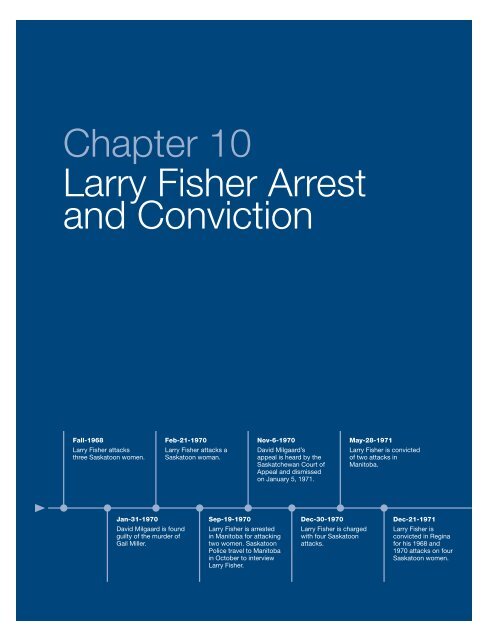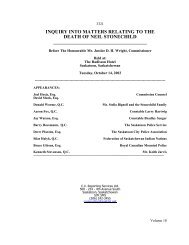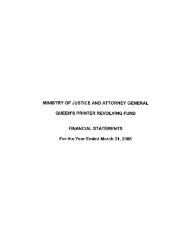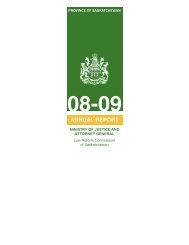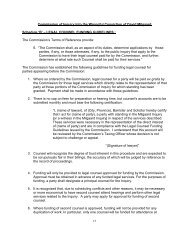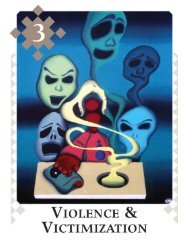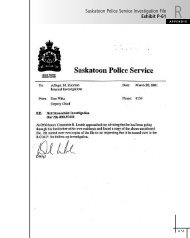Chapter 10 Larry Fisher Arrest and Conviction
Chapter 10 Larry Fisher Arrest and Conviction
Chapter 10 Larry Fisher Arrest and Conviction
Create successful ePaper yourself
Turn your PDF publications into a flip-book with our unique Google optimized e-Paper software.
<strong>Chapter</strong> <strong>10</strong><br />
<strong>Larry</strong> <strong>Fisher</strong> <strong>Arrest</strong><br />
<strong>and</strong> <strong>Conviction</strong><br />
Fall-1968<br />
<strong>Larry</strong> <strong>Fisher</strong> attacks<br />
three Saskatoon women.<br />
Feb-21-1970<br />
<strong>Larry</strong> <strong>Fisher</strong> attacks a<br />
Saskatoon woman.<br />
Nov-6-1970<br />
David Milgaard’s<br />
appeal is heard by the<br />
Saskatchewan Court of<br />
Appeal <strong>and</strong> dismissed<br />
on January 5, 1971.<br />
May-28-1971<br />
<strong>Larry</strong> <strong>Fisher</strong> is convicted<br />
of two attacks in<br />
Manitoba.<br />
Jan-31-1970<br />
David Milgaard is found<br />
guilty of the murder of<br />
Gail Miller.<br />
Sep-19-1970<br />
<strong>Larry</strong> <strong>Fisher</strong> is arrested<br />
in Manitoba for attacking<br />
two women. Saskatoon<br />
Police travel to Manitoba<br />
in October to interview<br />
<strong>Larry</strong> <strong>Fisher</strong>.<br />
Dec-30-1970<br />
<strong>Larry</strong> <strong>Fisher</strong> is charged<br />
with four Saskatoon<br />
attacks.<br />
Dec-21-1971<br />
<strong>Larry</strong> <strong>Fisher</strong> is<br />
convicted in Regina<br />
for his 1968 <strong>and</strong><br />
1970 attacks on four<br />
Saskatoon women.
1. Introduction<br />
Three sexual assaults, later attributed to <strong>Fisher</strong>, were committed in Saskatoon in the fall of 1968.<br />
He committed a further rape in 1970 in Saskatoon, after David Milgaard was convicted for the<br />
murder of Gail Miller.<br />
During the Miller murder investigation, some policemen thought that the perpetrator of the 1968<br />
sexual assaults might also be the murderer of Miller, but the rapist was unknown to them. They<br />
finally settled on Milgaard as the prime murder suspect <strong>and</strong> put aside the rape files. These remained<br />
unsolved until <strong>Fisher</strong> was apprehended for rape in Winnipeg, <strong>and</strong> stated that he wanted to clear up<br />
matters from Saskatoon. Two Saskatoon Police officers went to Winnipeg in October 1970 to take<br />
statements from <strong>Fisher</strong>. One of them, Eddie Karst, had worked on the Miller murder investigation.<br />
Karst testified that he drew no connection between the rapist <strong>Fisher</strong> <strong>and</strong> the murderer of Gail Miller.<br />
Karst reported to his superiors in Saskatoon, <strong>and</strong> Informations charging <strong>Fisher</strong> with the Saskatoon<br />
sexual assaults were drawn. About a year later, in 1971, <strong>Fisher</strong>, having pled guilty to the Winnipeg<br />
rapes, came to Regina <strong>and</strong> pled guilty to the Saskatoon offences, receiving concurrent jail sentences<br />
to the ones imposed by the Manitoba court for his offences there.
<strong>Chapter</strong> <strong>10</strong> <strong>Larry</strong> <strong>Fisher</strong> <strong>Arrest</strong> <strong>and</strong> <strong>Conviction</strong><br />
As a background to the reopening of the investigation into the death of Gail Miller, the Inquiry heard<br />
witnesses on the subject of significant events which occurred between the conviction of David Milgaard<br />
for murder <strong>and</strong> the guilty pleas of <strong>Larry</strong> <strong>Fisher</strong> in Regina.<br />
Within a month of Milgaard’s conviction on January 31, 1970, <strong>Fisher</strong> sexually assaulted another victim in<br />
Saskatoon. 1 In July 1970, he moved to Fort Garry, Manitoba to work, <strong>and</strong> committed sexual assaults in<br />
August <strong>and</strong> September 1970, being caught in the act for the latter offence.<br />
2. Allegations of Cover-up<br />
More than 20 years later, when Joyce Milgaard <strong>and</strong> her supporters tried to have Milgaard’s case<br />
reopened, <strong>Fisher</strong> came to their attention, <strong>and</strong> some of the Saskatoon rape files could not be found. Thus<br />
arose the allegation by the Milgaard group of a cover-up – that Saskatoon Police <strong>and</strong> Saskatchewan<br />
Justice officials concealed <strong>Fisher</strong>’s conviction in Saskatchewan for the Saskatoon rapes, so as to avoid<br />
the embarrassment of having convicted the wrong man for Miller’s murder.<br />
3. <strong>Larry</strong> <strong>Fisher</strong>’s Attacks in Saskatoon <strong>and</strong> Fort Garry<br />
The Milgaard campaign, to demonstrate a cover-up of evidence showing a connection between <strong>Fisher</strong>’s<br />
sexual assaults <strong>and</strong> the Gail Miller murder, began in earnest after the Supreme Court h<strong>and</strong>ed down its<br />
opinion in the Reference Case in 1992. It had three main bases: the Michael Breckenridge allegations, the<br />
missing sexual assault files, <strong>and</strong> the Regina guilty pleas. The first was preposterous on its face <strong>and</strong> was<br />
advanced, I find, simply as an attention getter. It resulted in the major RCMP/Alberta Justice investigation,<br />
Project Flicker. The missing files <strong>and</strong> the Regina guilty pleas were worthier of investigation. As it turned<br />
out, there were innocent explanations for both. However, the fact that Eddie Karst, one of the main Miller<br />
murder investigators, was sent to Winnipeg with a morality officer to take <strong>Fisher</strong>’s statement, coupled<br />
with <strong>Fisher</strong>’s guilty pleas having been heard in Regina instead of Saskatoon where the offences were<br />
perpetrated, gave the Milgaard group, legitimately, I think, something to look into, as did the fact that most<br />
of the <strong>Fisher</strong> Saskatoon sexual assault files could not be found.<br />
In my view, the Milgaard group was right to raise their concerns about the missing files <strong>and</strong> the Regina<br />
guilty pleas, <strong>and</strong> the authorities were right to make the major investigative efforts that they did to discover<br />
the reasons for these issues. But the publicity campaign which the Milgaard group mounted around these<br />
issues, including the Breckenridge allegations, were seen by authorities as so inflammatory, exaggerated,<br />
<strong>and</strong> inaccurate, that it had a counter-productive effect in terms of information which should have caused<br />
the authorities to reopen the investigation into the death of Gail Miller. Arguably, the campaign got<br />
Milgaard out of jail because the reference to the Supreme Court of Canada was made by the Minister, not<br />
because a cover-up was shown, but rather because such a public outcry had been generated that public<br />
confidence in the administration of justice was at risk.<br />
Caldwell was asked at the Inquiry about a possible cover-up of the <strong>Fisher</strong> sexual assault files. He said that<br />
the name <strong>Fisher</strong> meant nothing to him in 1971. I accept his assurance that he was never involved in a<br />
cover-up.<br />
Caldwell did not find it surprising that the rape victims were not notified of <strong>Fisher</strong>’s convictions. There<br />
was no system in place for notification. To me this is a matter for regret, to be sure, but however much<br />
it offends our present st<strong>and</strong>ards of dealing with victims, we cannot judge the authorities of the day by<br />
1 Docid <strong>10</strong>5212.<br />
580
<strong>Chapter</strong> <strong>10</strong> <strong>Larry</strong> <strong>Fisher</strong> <strong>Arrest</strong> <strong>and</strong> <strong>Conviction</strong><br />
appealing to today’s lively interest in closure, healing <strong>and</strong> victim impact statements. If I might be permitted<br />
personal recollection, at that time a complainant in a criminal case was just another witness, albeit an<br />
important one. The crime was an offence against the state, against public order. Victims seeking personal<br />
redress were expected to do so in civil court – a callous attitude, some might say, but one which existed<br />
for years after <strong>Fisher</strong> committed his crimes.<br />
(a) Saskatoon Assaults<br />
A few months before Gail Miller’s murder, <strong>Fisher</strong> Victim 1 <strong>and</strong> <strong>Fisher</strong> Victim 2 were raped by <strong>Fisher</strong> in the<br />
general neighbourhood of the murder. He also assaulted <strong>Fisher</strong> Victim 3 near the University. On the day of<br />
the murder, Victim 12 was assaulted about seven blocks from the murder scene at about the time of the<br />
murder. <strong>Fisher</strong> did not take responsibility for the attack on V12, <strong>and</strong> nobody was prosecuted. In February<br />
of 1970, within a month of the Milgaard trial, <strong>Fisher</strong> raped <strong>Fisher</strong> Victim 4 in the same general area of<br />
Saskatoon where he committed his earlier rapes.<br />
As noted earlier, the Milgaard group has always maintained that <strong>Fisher</strong>’s 1968 <strong>and</strong> 1970 sexual assaults<br />
were so similar to the circumstances of the Gail Miller murder that the police should have concluded there<br />
was a common perpetrator. They maintain that the Crown, in fact, concluded this in 1970, but covered<br />
it up.<br />
The Commission therefore thought it necessary to once again trouble the victims of the sexual assaults<br />
for their testimony to identify, if possible, whether the obvious had been overlooked, ignored, or covered<br />
up. The relevance is not what <strong>Fisher</strong> did to them, but rather what they reported at the time, <strong>and</strong> what use<br />
was made of their reports by the authorities for the Milgaard prosecution. The Milgaards have alleged<br />
that the similarity of the <strong>Fisher</strong> attacks <strong>and</strong> the attack on Gail Miller was recognized both before <strong>and</strong> after<br />
the Milgaard trial. However, they allege that appropriate action was not taken before the trial, <strong>and</strong> once<br />
<strong>Fisher</strong>’s identity came to light after the trial his rapes <strong>and</strong> convictions were concealed by the authorities.<br />
Were it not for these serious allegations, the victims would not have been called to be put through, once<br />
more, the trauma of testifying. Steps were taken, however, to minimize their public exposure <strong>and</strong> to<br />
preserve anonymity through publication bans. Details of <strong>Fisher</strong>’s assaults were read in from documents as<br />
opposed to being recited by the victims. Except in the case of Victim 12, who was indecently assaulted in<br />
the general vicinity of the murder around the same time, the victims were not cross-examined by counsel<br />
extensively.<br />
<strong>Fisher</strong> Victim 1 was raped by <strong>Fisher</strong> on October 22, 1968. Relevant documents were read in prior to her<br />
testimony. In them, she described her attacker as 5’2” to 5’4” tall, around 18 years old, with dark hair<br />
hanging over his face. He used a knife in the attack.<br />
<strong>Fisher</strong> Victim 2 described her attacker, who raped her on November 13, 1968, as a man 18 to 25 years<br />
old, 5’5” tall with dark hair which hung over his forehead, wearing a white hard hat <strong>and</strong> smelling of oil <strong>and</strong><br />
gas. He used a knife.<br />
<strong>Fisher</strong> Victim 3 was attacked on November 29, 1968, according to her statement, 2 by a man with a knife,<br />
about 20 years old, 5’6” tall with long dark hair. He was frightened off by an approaching vehicle before he<br />
could complete the rape.<br />
2 Docid 065330.<br />
581
<strong>Chapter</strong> <strong>10</strong> <strong>Larry</strong> <strong>Fisher</strong> <strong>Arrest</strong> <strong>and</strong> <strong>Conviction</strong><br />
Victim 12 was indecently assaulted on her way to the bus stop at around 7:00 a.m. on January 31, 1969.<br />
She fixes the time at 7:07 a.m. because she looked at her watch, but she always kept it a few minutes<br />
fast. It took <strong>10</strong> to 12 minutes to walk from her house at Avenue H <strong>and</strong> 19th Street to the bus stop at<br />
Avenue H <strong>and</strong> 22nd Street. She described her attacker as 5’5” or 5’6” tall wearing a three‐quarter length<br />
dark suede or leather jacket with a fur collar. He wore only one glove on his left h<strong>and</strong>. He had a darker<br />
complexion – possibly Métis. When Victim 12 heard of the murder she reported her own attack assuming<br />
the murderer had also attacked her. She was shown a photo line-up but made no identification. Her<br />
report 3 was recorded on the Miller murder file because she was not making the complaint on her own<br />
account.<br />
A map 4 shows the site of the attack, just south of the tracks at 22nd Street <strong>and</strong> Avenue H, which would<br />
be about seven blocks from the Miller murder scene.<br />
<strong>Fisher</strong> Victim 4 was raped by <strong>Larry</strong> <strong>Fisher</strong> on February 21, 1970, less then a month after Milgaard’s<br />
conviction for murder. 5 She told police that she would recognize her attacker <strong>and</strong> she did when later<br />
shown a photo of <strong>Fisher</strong> after his arrest in Winnipeg.<br />
Two former Saskatoon Police officers testified about the <strong>Fisher</strong> Victim 4 rape complaint in February 1970.<br />
One of them was Harry Valila who was aware of the <strong>Fisher</strong> Victim 4 matter, but not of the two 1968<br />
rapes <strong>and</strong> one attempt. Here, again, we have an example of an officer in the Saskatoon Police who was<br />
unaware of what the Milgaard counsel in this Inquiry have described as the activities of a notorious, serial<br />
rapist.<br />
Valila helped in the Miller investigation <strong>and</strong> answered a complaint of David Milgaard being a nuisance<br />
in April 1969. 6 He made no comparison between the <strong>Fisher</strong> Victim 4 <strong>and</strong> the Miller matters. He found<br />
nothing unusual about Karst being sent to Winnipeg with Nordstrom, <strong>and</strong> described Karst as a good<br />
investigator.<br />
Another officer, Stanley (Gus) Weir, was a morality officer in 1969 <strong>and</strong> 1970, <strong>and</strong> was in charge of the<br />
<strong>Fisher</strong> Victim 4 rape investigation. He dictated his reports to be typed by Central Records in three copies;<br />
one for Central Records, a working copy for the investigator, <strong>and</strong> another for a purpose unknown to him.<br />
When a file was concluded, a report to that effect would be left on file for review by his superior. Weir<br />
could not tell us where the file went after that. Nor was he clear on how files were managed when active<br />
investigation had ceased because no suspect was found.<br />
He thinks that the general practice was to inform victims of rape when their files were concluded, but the<br />
process was hit <strong>and</strong> miss. He told one of the <strong>Fisher</strong> rape victims, <strong>Fisher</strong> Victim 4, about the disposition of<br />
her case on February 5, 1971. 7<br />
I conclude from Weir’s evidence that there simply was no system in place which ensured that investigating<br />
morality officers would follow their files once they stopped working on them.<br />
3 Docid <strong>10</strong>61<strong>10</strong>.<br />
4 Docid 164351.<br />
5 Docid 261590.<br />
6 Docid <strong>10</strong>6115, <strong>10</strong>6179, <strong>10</strong>6534 <strong>and</strong> 048933.<br />
7 Docid <strong>10</strong>5246.<br />
582
<strong>Chapter</strong> <strong>10</strong> <strong>Larry</strong> <strong>Fisher</strong> <strong>Arrest</strong> <strong>and</strong> <strong>Conviction</strong><br />
Weir said that there was a good working relationship between morality officers <strong>and</strong> detectives.<br />
For example, Raymond Mackie helped Weir <strong>and</strong> his partner, Ivan Lindgren, with the <strong>Fisher</strong> Victim 4<br />
complaint. Weir recalls comparing the other rape complaints for links to his file, but finding no similarities.<br />
The Weir <strong>and</strong> Lindgren occurrence report of the <strong>Fisher</strong> Victim 4 complaint records a thorough<br />
investigation. 8 Many leads were followed <strong>and</strong> many photos were shown to the complainant to no avail.<br />
<strong>Fisher</strong> was simply unknown to the police, until his arrest in Winnipeg.<br />
The Inquiry heard commentary from many witnesses, which confirmed the Saskatoon Police assessment<br />
at the time that these attacks were probably the work of one man. However, they did not bear a striking<br />
resemblance to the attack on Gail Miller, the chief difference being the level of violence involved. They did<br />
not ignore the possibility that the rapist was also the killer of Gail Miller, but they simply could not identify a<br />
suspect for the rapes, <strong>and</strong> it was obvious from the description of the rapist that it was not Milgaard. I am<br />
satisfied that they did not overlook or ignore any evidence then available to them which would have linked<br />
<strong>Fisher</strong> to the murder.<br />
Former Morality Officer, Beverly Cressman, testified that his division had conducted decoy <strong>and</strong><br />
surveillance operations in the area in late 1968, in pursuit of the rapist. After the murder, he briefly<br />
considered whether it was connected to the rapes but was persuaded by another officer that it was not,<br />
because of the dissimilarity in the level of violence. He could not recall any connection having been drawn<br />
between the <strong>Fisher</strong> Victim 4 rape <strong>and</strong> the 1968 rapes until after <strong>Fisher</strong>’s apprehension. At about this<br />
time, he was asked to check on <strong>Fisher</strong>’s addresses at the time of the offences. He made no connection<br />
between <strong>Fisher</strong> <strong>and</strong> the Miller murder at this time, <strong>and</strong> the fact that he was asked to do this tends to<br />
negate any suggestion that his superior officers were trying to deal with the <strong>Fisher</strong> matters quietly. He had<br />
no concerns about Eddie Karst going to Winnipeg to interview <strong>Fisher</strong> about the rapes because, of the two<br />
of them, Karst was the more experienced.<br />
(b) Fort Garry Assaults<br />
Lorne Huff was with the Fort Garry police from 1961 to 1974 before serving, after amalgamation, with<br />
the Winnipeg City Police until 1987. Huff dealt with the rapes of <strong>Fisher</strong> Victim 5 <strong>and</strong> <strong>Fisher</strong> Victim 6 in<br />
Fort Garry in 1970. 9 He was able to give valuable background information concerning <strong>Fisher</strong>’s activities in<br />
Winnipeg <strong>and</strong> his guilty pleas there.<br />
<strong>Fisher</strong> was arrested at the scene of <strong>Fisher</strong> Victim 6’s rape. He had not been known to police. He was<br />
held, pending conclusion of court proceedings, at Headingly Jail while on rem<strong>and</strong>, <strong>and</strong> at the Vaughn<br />
Street Court Detention Centre.<br />
<strong>Fisher</strong> at first declined to give a statement, <strong>10</strong> but then provided information about <strong>Fisher</strong> Victim 6, 11 then<br />
<strong>Fisher</strong> Victim 5, 12 the last was prompted when Huff asked him how he would feel if his daughter had been<br />
raped. 13 Huff told the Inquiry, <strong>and</strong> I accept, that <strong>Fisher</strong> had bruises which, he told him, resulted from a<br />
beating he received at Headingly which involved the guards there.<br />
8 Docid 261590.<br />
9 Docid 321248, 002043, 071223, 321222 <strong>and</strong> 261217.<br />
<strong>10</strong> Docid 261231.<br />
11 Docid 255034.<br />
12 Docid 002032.<br />
13 Docid 093325.<br />
583
<strong>Chapter</strong> <strong>10</strong> <strong>Larry</strong> <strong>Fisher</strong> <strong>Arrest</strong> <strong>and</strong> <strong>Conviction</strong><br />
In his interview on October 21, 1970, <strong>Fisher</strong> told Huff of two incidents in Saskatoon, one rape <strong>and</strong> one<br />
attempt. Huff recalled one of the two Saskatoon officers who came to interview <strong>Fisher</strong> as being very big<br />
– a description which would fit Eddie Karst. Huff said that he <strong>and</strong> his partner were not present when the<br />
Saskatoon police officers interviewed <strong>Fisher</strong>.<br />
Huff seemed to have a clear memory of events, <strong>and</strong> I accept his evidence.<br />
4. Involvement of Saskatoon City Police<br />
Fort Garry police wrote to the Saskatoon Police on September 25, 1970 14 seeking any help they might be<br />
able to provide in view of <strong>Fisher</strong>’s recent residence in Saskatoon. <strong>Fisher</strong> had apparently been interviewed<br />
about the Saskatoon offences, but denied being involved. In a further interview with Huff, however, on<br />
October 21, 1970, <strong>Fisher</strong> confessed to a rape <strong>and</strong> an attempted rape in Saskatoon. 15 This prompted<br />
Saskatoon Police to send Eddie Karst <strong>and</strong> Hilmer Nordstrum to Winnipeg, to interview <strong>Fisher</strong> on<br />
October 22, 1970. 16<br />
The Saskatoon Police had morality <strong>and</strong> detective divisions. The latter did not normally involve itself in<br />
the investigation of sexual assaults. Thus, the Milgaard group concluded that Karst, who had worked on<br />
the Miller murder investigation, was sent to Winnipeg to investigate a sexual assault suspect precisely<br />
because a link between the murder <strong>and</strong> rapes was suspected. Karst has consistently denied this.<br />
Other officers said that Karst was sent to Winnipeg simply because he was a highly capable investigator.<br />
When asked about it years later, Karst could not even remember going to Winnipeg at first, but when<br />
shown a copy of a report he had apparently authored, he conceded that he must have gone.<br />
Joseph Penkala testified that he was not aware of <strong>Fisher</strong>’s arrest in Winnipeg, or of his confession to the<br />
Saskatoon sexual assaults, <strong>and</strong> I accept that. Nor was there anything unusual, in his view, about Karst<br />
being sent to Winnipeg with Nordstrum to take <strong>Fisher</strong>’s statement. It did not surprise him that, although<br />
<strong>Fisher</strong> was charged with the rapes <strong>and</strong> pled guilty in Regina, police did not follow up on a possible<br />
connection with the Miller murder. They had a conviction for the latter <strong>and</strong> were busy with new challenges.<br />
Coming from an officer who was involved in the Miller murder investigation, <strong>and</strong> who later became Chief<br />
of Police in Saskatoon, <strong>and</strong> served with distinction in that post, the evidence is of significant weight.<br />
Penkala testified at length at the Inquiry <strong>and</strong> I found him to be frank, credible <strong>and</strong> helpful.<br />
In <strong>Fisher</strong>’s statement of October 22, 1970, 17 given to Karst in Winnipeg, he gave his address as 1824<br />
Avenue D North in Saskatoon. This was not Cadrain’s address; so Karst would not have been alerted. It<br />
appears that Karst had with him the <strong>Fisher</strong> Victim 3 <strong>and</strong> <strong>Fisher</strong> Victim 4 files, but probably not the <strong>Fisher</strong><br />
Victim 1 <strong>and</strong> <strong>Fisher</strong> Victim 2 files, because he was not expecting a statement from <strong>Fisher</strong> about them. He<br />
thinks from the lack of detail in the statements he took, that he had no inkling of <strong>Fisher</strong> being involved in<br />
other rapes. Had he suspected that, he would have gone into detail about the method of operation.<br />
One must be careful to distinguish between what Karst knew during the investigative stage of the Miller<br />
murder file <strong>and</strong> what he later knew. As his April 18, 1969 report 18 shows, he was aware of the connection<br />
being made between the rapes <strong>and</strong> the murder. But he says that whatever the motivation of his superiors<br />
14 Docid 002021.<br />
15 Docid 002032.<br />
16 Docid 012639, 012656.<br />
17 Docid 012656.<br />
18 Docid <strong>10</strong>6664.<br />
584
<strong>Chapter</strong> <strong>10</strong> <strong>Larry</strong> <strong>Fisher</strong> <strong>Arrest</strong> <strong>and</strong> <strong>Conviction</strong><br />
in sending him to Winnipeg a year <strong>and</strong> a half later to take <strong>Fisher</strong>’s guilty pleas, his mind must have been<br />
closed to the connection, or he would have asked appropriate questions of <strong>Fisher</strong>.<br />
5. Prosecution of <strong>Fisher</strong> for Saskatchewan Assaults<br />
(a) Introduction<br />
<strong>Fisher</strong> had to be dealt with in Manitoba for the Fort Garry offences, <strong>and</strong> in Saskatchewan for the<br />
Saskatoon offences.<br />
He pled guilty in Winnipeg for the Fort Garry offences <strong>and</strong> received a sentence of 13 years.<br />
The disposition of the Saskatoon charges required his removal to Saskatchewan. The manner in which<br />
that was done gave rise later to charges by the Milgaard group of a cover-up of the Saskatoon offences,<br />
so as to conceal their connection with the murder of Gail Miller, specifically:<br />
• The Saskatchewan Crown Prosecutor h<strong>and</strong>ling the <strong>Fisher</strong> charges, Serge Kujawa, was the same<br />
prosecutor h<strong>and</strong>ling Milgaard’s appeals during the same time period. It would later be alleged<br />
that Kujawa had both files, that anyone in possession of this material would have concluded<br />
<strong>Fisher</strong> had raped <strong>and</strong> murdered Gail Miller, <strong>and</strong> that Kujawa in fact had drawn this conclusion,<br />
but had decided to cover it up.<br />
• <strong>Fisher</strong>’s Saskatoon offences were charged by way of direct indictment, a seldom used process<br />
which obviates the need for a preliminary inquiry <strong>and</strong> appearances by the accused both in the<br />
provincial court <strong>and</strong> in the Court of Queen’s Bench. The Attorney General of Saskatchewan was<br />
a necessary signatory to the direct indictment, <strong>and</strong> it would later be argued that authorities chose<br />
the process so that the charges could be h<strong>and</strong>led quickly <strong>and</strong> inconspicuously.<br />
• <strong>Fisher</strong> entered his guilty pleas in Regina as opposed to Saskatoon where the public would<br />
be more likely to draw a connection with the Miller murder. He was taken from Prince Albert<br />
Penitentiary to Regina instead of Saskatoon, which would have been closer. Milgaard’s<br />
prosecutor, Caldwell, was implicated in the arrangement.<br />
• He pled guilty just before Christmas in 1971, on a date chosen to avoid publicity, <strong>and</strong> after<br />
the Supreme Court of Canada had rejected Milgaard’s application for leave to appeal on<br />
November 15, 1971.<br />
• Notwithst<strong>and</strong>ing the severity of the Saskatoon offences, Kujawa agreed to terms of imprisonment<br />
to be served concurrently with the time received in Manitoba, so in the result <strong>Fisher</strong> received<br />
no extra prison time for his Saskatoon offences – clearly a favor extended to <strong>Fisher</strong> for his<br />
agreement to quietly plead guilty in Regina.<br />
• The Regina media did not report the guilty pleas.<br />
• Some of the Saskatoon rape victims were not told of the disposition of their cases, nor were<br />
some of the investigators involved.<br />
• After <strong>Fisher</strong> came to the attention of the Milgaard group in the early 1990s, some of the original<br />
Saskatoon rape files could not be found, <strong>and</strong> must have been concealed or destroyed in<br />
furtherance of a cover-up.<br />
585
<strong>Chapter</strong> <strong>10</strong> <strong>Larry</strong> <strong>Fisher</strong> <strong>Arrest</strong> <strong>and</strong> <strong>Conviction</strong><br />
• Kujawa, the Minister of Justice <strong>and</strong> other officials realized that the Milgaard conviction was a<br />
mistake <strong>and</strong> held closed door meetings involving the Miller murder file <strong>and</strong> the <strong>Fisher</strong> rape files.<br />
The Saskatoon Crown office had no substantial involvement in the matter of <strong>Fisher</strong>’s guilty pleas in<br />
Regina. Information about the sexual assaults in Saskatoon was requested by the Regina Crown office so<br />
that Kujawa, Director of Public Prosecutions, could inform himself for the purpose of speaking to the guilty<br />
pleas. The request went to Caldwell in the Saskatoon Crown office, who passed it along to the Saskatoon<br />
Police, who replied directly to Regina with the information needed. I accept Caldwell’s testimony that<br />
he had no interest in the matter beyond passing on the request for information <strong>and</strong> evidence to the<br />
Saskatoon Police. I am satisfied that the police h<strong>and</strong>led the request without reference to the Miller murder<br />
file – in fact without even thinking about that file.<br />
The Saskatoon rape files were concluded in Regina with no official report having been made to the<br />
Saskatoon Crown office or to the police there.<br />
It is uncertain what became of the Saskatoon sexual assault files. The Milgaard group was to allege<br />
that the files were destroyed by Saskatoon Police as part of a cover-up. This became the subject of<br />
a Saskatchewan Police Commission investigation which found that the files had probably been lost in<br />
the course of a move of police headquarters in Saskatoon. But the possibility also exists that the files<br />
remained in the office of the City Prosecutor, Ben Wolff. 19<br />
(b) Key Witnesses <strong>and</strong> the Documentary Record<br />
(i)<br />
Lawrence Greenberg<br />
Greenberg was an important witness on the subject of <strong>Fisher</strong>’s guilty pleas in Regina. He was <strong>Fisher</strong>’s<br />
Winnipeg lawyer. He no longer has his file but was able to reconstruct a comprehensive narrative<br />
from Commission documents, including the initial crime report on the <strong>Fisher</strong> Victim 5 assault, 20 the<br />
supplementary report, 21 <strong>and</strong> the report on the <strong>Fisher</strong> Victim 6 assault. 22<br />
Within days of these two rapes, <strong>Fisher</strong> told Greenberg of his involvement in them, instructing him to have<br />
guilty pleas entered as quickly as possible. Greenberg was not present when the <strong>Fisher</strong> statements were<br />
taken. <strong>Fisher</strong> had no criminal record <strong>and</strong> there was no discussion of the Miller murder. Greenberg was<br />
unaware of it, or of Milgaard’s conviction.<br />
Learning of the Saskatoon matters, Greenberg testified that he hoped to dispose of everything at once or<br />
at least avoid separate sentencing <strong>and</strong> consecutive penalties.<br />
The offences were indictable, <strong>and</strong> were within the exclusive jurisdiction of the Superior Court, namely the<br />
Court of Queen’s Bench in Saskatchewan.<br />
A preliminary hearing before the Saskatchewan provincial court was required unless waived. Alternatively,<br />
the matter could proceed by way of direct indictment, preferred by the Saskatchewan Attorney General,<br />
directly to the Saskatchewan Court of Queen’s Bench. The accused wanted to plead guilty <strong>and</strong> not go to<br />
trial, so a preliminary inquiry was not needed. Greenberg’s choices therefore were a consent committal,<br />
which needed an appearance in provincial court, or a direct indictment bypassing that court altogether.<br />
19 T13797-T13820.<br />
20 Docid 321248.<br />
21 Docid 002043.<br />
22 Docid 261217.<br />
586
<strong>Chapter</strong> <strong>10</strong> <strong>Larry</strong> <strong>Fisher</strong> <strong>Arrest</strong> <strong>and</strong> <strong>Conviction</strong><br />
As well, the accused had to dispose of the Manitoba <strong>and</strong> Saskatchewan charges in those respective<br />
provinces. So Greenberg’s aim was to have his client sentenced on the Manitoba matters, <strong>and</strong> then go to<br />
Saskatchewan to be sentenced there, with assurance that <strong>Fisher</strong>’s time for the Saskatchewan offences<br />
would be concurrent with the sentences imposed in Manitoba. He said that he received such assurance,<br />
although he has no supporting documentation. I accept his evidence.<br />
Greenberg wrote to the federal Minister of Justice asking for his cooperation in ensuring that <strong>Fisher</strong> plead<br />
to the Manitoba charges, <strong>and</strong> then the Saskatchewan charges in special sittings as close together as<br />
possible, so that he could begin serving his time without delay. 23 Greenberg was anxious to conclude<br />
matters because his client had been beaten in prison <strong>and</strong> his mental condition was deteriorating.<br />
Greenberg consented to committal in Manitoba on February 12, 1971. 24 He wrote to Saskatchewan on<br />
March 12, 1971, 25 dem<strong>and</strong>ing attention to <strong>Fisher</strong>’s case. The Saskatchewan Attorney General replied<br />
March 18, 1971, 26 saying that inquiries were being made.<br />
Correspondence passed between Greenberg, Correctional Services Canada <strong>and</strong> Saskatchewan. 27<br />
Greenberg wanted assurance that <strong>Fisher</strong> would serve his sentence in Saskatchewan before disposition<br />
of the Manitoba matters. He said that it made no difference to him as to where his client pled in<br />
Saskatchewan. He left that up to the Saskatchewan Attorney General, 28 <strong>and</strong> would have sought their<br />
agreement to concurrent sentences in the <strong>10</strong> - 15 year range.<br />
According to Greenberg, the 13 year sentence <strong>Fisher</strong> received in Manitoba was not low. The media<br />
reported that “<strong>Fisher</strong> will face similar charges in Saskatoon”. 29 The matter was reported in Saskatoon. On<br />
June 2, 1971, Greenberg wrote to Saskatchewan asking for a hearing date, 30 reporting the results of the<br />
Manitoba pleas, <strong>and</strong> offering to send the pre-sentence report for the use of the Court <strong>and</strong> the Attorney<br />
General. There is no mention of a deal for concurrent time, or of a venue for the guilty pleas. Obviously,<br />
Greenberg was relying on verbal arrangements for sentence, <strong>and</strong> <strong>Fisher</strong> was willing to take his chances. 31<br />
Greenberg pressed for a hearing date by letter on June 11, 1971. 32 Action was taken by Kujawa, the<br />
Saskatchewan Director of Public Prosecutions. 33 His letter of June 25, 1971, makes the case for a direct<br />
indictment, <strong>and</strong> explains that without <strong>Fisher</strong>’s confession there was no evidence against him.<br />
A change in government in Saskatchewan ensued, <strong>and</strong> on December 8, 1971, Kujawa wrote to the new<br />
acting Attorney General, Allan Blakeney, 34 repeating his request for a direct indictment. In the meantime,<br />
<strong>Fisher</strong> was incarcerated in Prince Albert, his penitentiary of choice, so the sense of urgency, I conclude,<br />
had largely passed. 35<br />
23 Docid 331515.<br />
24 Docid 331519.<br />
25 Docid 033361.<br />
26 Docid 039593.<br />
27 Docid 331530, 0<strong>10</strong>714 <strong>and</strong> 0<strong>10</strong>727.<br />
28 Docid 0<strong>10</strong>7<strong>10</strong>.<br />
29 Docid 159726.<br />
30 Docid 039581.<br />
31 Docid 020185.<br />
32 Docid 039579.<br />
33 Docid 0<strong>10</strong>690 <strong>and</strong> 019369.<br />
34 Docid 30<strong>10</strong>73.<br />
35 Docid 042968.<br />
587
<strong>Chapter</strong> <strong>10</strong> <strong>Larry</strong> <strong>Fisher</strong> <strong>Arrest</strong> <strong>and</strong> <strong>Conviction</strong><br />
Greenberg could not say whether he suggested the direct indictment. All he wanted was the most<br />
expeditious choice. I am satisfied that Greenberg did not specify a venue, nor did he discuss with anyone<br />
a possible connection between <strong>Fisher</strong> <strong>and</strong> the Miller murder. It has been suggested that authorities<br />
were awaiting the expiration of the Milgaard appeal period before taking <strong>Fisher</strong>’s guilty pleas for the<br />
Saskatchewan offences. But it was Greenberg’s evidence, which I accept, that he had no sense that the<br />
Saskatchewan Attorney General’s Department was taking unusual steps or trying to delay disposition of<br />
the <strong>Fisher</strong> matters. He did not see, observe, or think of anything suggesting a conspiracy or cover-up in<br />
the h<strong>and</strong>ling of the charges.<br />
The arrangement needed to accomplish Greenberg’s strategy was not simple to organize, involving two<br />
separate provincial courts, the Federal <strong>and</strong> Provincial Justice Departments, Corrections Canada, <strong>and</strong> a<br />
change in Saskatchewan’s Government.<br />
Once <strong>Fisher</strong> had pled guilty in Manitoba, Greenberg had assurance of concurrent time in Saskatchewan<br />
<strong>and</strong> his client was soon sent to Prince Albert where he wanted to be, so there was no more urgency,<br />
aside from a desire to close the file. 36<br />
Twenty years later, commentators like Timothy Appleby <strong>and</strong> David Roberts with the Globe <strong>and</strong> Mail, 37<br />
purported to find something sinister in the arrangement described in the Kujawa memo of December 8,<br />
1971 38 . Greenberg begged to differ. He emphatically stated that there was no intent to have <strong>Fisher</strong> “quietly<br />
plead guilty” 39 . As for waiting for conclusion of the Milgaard appeals, Greenberg had never heard the<br />
name. Regina was chosen as venue for the guilty pleas because the direct indictment had to be arranged<br />
through Kujawa <strong>and</strong> the Attorney General, who were both located in Regina.<br />
<strong>Fisher</strong> was indicted in Regina on December 8, 1971, 40 <strong>and</strong> pled guilty to the rapes of <strong>Fisher</strong> Victim 1,<br />
<strong>Fisher</strong> Victim 2, <strong>Fisher</strong> Victim 4, <strong>and</strong> the indecent assault of <strong>Fisher</strong> Victim 3 on December 21, 1971. He<br />
received four years on each rape, <strong>and</strong> six months on the indecent assault, all concurrent to the sentences<br />
imposed for his Winnipeg offences. In his memor<strong>and</strong>um to file dated December 24, 1971, 41 Kujawa<br />
remarked that <strong>Fisher</strong>’s confession, not likely admissible, was the only evidence against him.<br />
(ii) <strong>Larry</strong> <strong>Fisher</strong><br />
<strong>Fisher</strong>’s responsibility for the rape <strong>and</strong> murder of Gail Miller was not an issue in this Inquiry. His conviction<br />
is final. Potentially, of course, he had much to offer in terms of clearing up the circumstances surrounding<br />
Gail Miller’s death, <strong>and</strong> its investigation <strong>and</strong> prosecution. He was not a helpful witness, but certain things<br />
he said could be verified by reference to other evidence.<br />
<strong>Fisher</strong> readily admitted the Fort Garry rapes. He says that his confessions were prompted by a desire<br />
to get out of Headingley where he had been assaulted by guards. That led to his confession to the<br />
Saskatchewan matters. 42 Although he recalls being interviewed by Saskatoon officers, he could not<br />
remember by how many, or what they looked like. He does not recall the name Eddie Karst. He agrees<br />
that his instructions to Greenberg were to dispose of all charges by guilty pleas as quickly as possible.<br />
36 Docid 043020.<br />
37 Docid 219266 at 219270 <strong>and</strong> 219271.<br />
38 Docid 30<strong>10</strong>73.<br />
39 T13961.<br />
40 Docid 039601.<br />
41 Docid 042960.<br />
42 Docid 002032.<br />
588
<strong>Chapter</strong> <strong>10</strong> <strong>Larry</strong> <strong>Fisher</strong> <strong>Arrest</strong> <strong>and</strong> <strong>Conviction</strong><br />
He left the place of pleas to Greenberg. He did not care what time he got. He was never told that the<br />
pleas would take place in Regina to avoid publicity in Saskatoon. He said that his abusive treatment in<br />
Headingley led him to make a statement. Whether that is true or not, the mistreatment appears to have<br />
happened, according to Huff, a former Fort Garry policeman, so the admissibility of the statement might<br />
well have been affected as Kujawa remarked in his letter to the Acting Attorney General.<br />
Although arrested only in 1997 for the rape <strong>and</strong> murder of Miller, <strong>Fisher</strong> has been incarcerated, except<br />
for a few years, since 1971 for various crimes. 43 His first involvement with the courts was in 1971 <strong>and</strong>, he<br />
says, he relied on his lawyer. Consecutive <strong>and</strong> concurrent sentences were terms unknown to him. His only<br />
concern was total time. He agreed with Kujawa’s views of June 25, 1971, 44 that he wanted to clear his<br />
record for a fresh start. He said that he did not know the name David Milgaard.<br />
As mentioned, the Milgaard group’s suspicions of a cover-up were excited by the fact that <strong>Fisher</strong> pled<br />
guilty to Saskatoon offences in Regina, when the usual practice was to have guilty pleas heard as near<br />
as possible to the place where the offences occurred. Also, <strong>Fisher</strong> received sentences for the very<br />
serious Saskatoon offences concurrent to the sentences he had received in Manitoba. The fact that the<br />
sentences were not consecutive told the group that authorities had made a deal with <strong>Fisher</strong> to plead guilty<br />
in Regina, where there would be no publicity in exchange for concurrent time.<br />
(iii) Kenneth MacKay<br />
MacKay, formerly of the Saskatchewan Attorney General’s Department, was a reliable <strong>and</strong> informative<br />
witness on the workings of the department at relevant times.<br />
From 1969 to 1973, MacKay was a junior lawyer in the Regina office under Serge Kujawa, the Director of<br />
Public Prosecutions. Kujawa did all the appeal work for both the Saskatchewan Court of Appeal <strong>and</strong> the<br />
Supreme Court of Canada, leaving little time for administrative duties which were performed by a junior<br />
in the department, Elizabeth McFadyen. MacKay began working for the Attorney General in Regina only<br />
after the Miller murder, of which he was unaware.<br />
MacKay was able to explain what information relating to the Milgaard <strong>and</strong> <strong>Fisher</strong> cases came to the<br />
Regina office of the Attorney General <strong>and</strong> how it was h<strong>and</strong>led, a subject of interest to us because of the<br />
allegation that Kujawa made the connection between the murder <strong>and</strong> the <strong>Fisher</strong> sexual assaults, <strong>and</strong><br />
covered it up.<br />
Commission Counsel prepared an index 45 listing 137 documents related to the Milgaard file that were<br />
apparently in the possession of the Attorney General’s office in Regina. Included are reports authored by<br />
J.A.B. Riddell <strong>and</strong> Edwin Rasmussen, <strong>and</strong> some substantive material such as witness statements, as well<br />
as administrative material. The original Milgaard prosecution file, however, remained in Saskatoon.<br />
A large number of RCMP reports came to the office as a matter of course because that force policed<br />
the province under contract with the Attorney General. Although Kujawa’s name appears on some of<br />
the reports, it is doubtful that he read any of them. Some are marked with the initials of his assistant,<br />
McFayden. MacKay says that McFayden probably read the letters <strong>and</strong> reports. If something was marked<br />
as needing action, Kujawa might read it, but it would receive attention in any case. The flow of material<br />
did not have a functional purpose beyond general information for contractual purposes, or for briefing<br />
43 Docid 331771, 067059.<br />
44 Docid 0<strong>10</strong>690.<br />
45 Docid 335498.<br />
589
<strong>Chapter</strong> <strong>10</strong> <strong>Larry</strong> <strong>Fisher</strong> <strong>Arrest</strong> <strong>and</strong> <strong>Conviction</strong><br />
the Minister if the case were notorious. Kujawa, not an “enthusiastic manager”, 46 did not prepare briefing<br />
notes said MacKay, his interest being in the court room. When he himself became appellate counsel,<br />
MacKay never looked at police reports. His interest was the record.<br />
Caldwell reported on the Milgaard preliminary inquiry, 47 (a report likely read by McFadyen), <strong>and</strong> on<br />
the trial. 48 Kujawa argued the appeal on November 6, 1970, <strong>and</strong> reasons for dismissal were given on<br />
January 5, 1971. No factums were filed, <strong>and</strong> MacKay does not recall receiving the trial prosecutor’s file for<br />
purpose of the appeal. A transcript of the evidence was received. 49<br />
MacKay thought that in view of the 13 year Manitoba sentence, asking for more time in Saskatchewan<br />
would have been futile. Concurrent sentences in such situations were not unusual in Saskatchewan.<br />
I accept this.<br />
MacKay passed the Manitoba report 50 of June 7, 1971, onto Kujawa who required the information to<br />
speak to the guilty pleas.<br />
The clearest proof of the reason for the direct indictment procedure is to be found in Kujawa’s letter to the<br />
Attorney General on June 25, 1971. 51 I find from this, <strong>and</strong> from Kujawa <strong>and</strong> other evidence, that without<br />
<strong>Fisher</strong>’s Manitoba confessions Saskatchewan had no proof against him for the Saskatoon offences. Thus,<br />
<strong>Fisher</strong>’s willingness to plead guilty to the Saskatoon offences would be reason enough to accommodate<br />
him for speedy disposition by way of direct indictment. <strong>Fisher</strong> could start anew, <strong>and</strong> Saskatchewan could<br />
clear the charges from its books. Incidentally, the guilty pleas, I find, would be of significant weight in<br />
mitigation. Without them, Saskatchewan would be left with four unresolved, serious cases.<br />
As to the difficulty of proving the <strong>Fisher</strong> crimes in Saskatchewan, notwithst<strong>and</strong>ing the confessions in<br />
Manitoba, MacKay recalled some issue with <strong>Fisher</strong> having been beaten <strong>and</strong> wanting to get out of the<br />
situation he was in. This would affect admissibility.<br />
Arrangements were finally made to have <strong>Fisher</strong>’s guilty pleas heard in Regina on December 21, 1971. 52<br />
The location was chosen as a matter of convenience. MacKay saw nothing unusual in the December 21st<br />
date, which the Milgaard group had alleged was chosen in furtherance of a cover-up. A judge was<br />
available <strong>and</strong> everyone wanted to dispose of the matter before Christmas. 53 MacKay wrote to <strong>Fisher</strong><br />
confirming the arrangements, <strong>and</strong> confirming that the Crown would be consenting to concurrent<br />
sentences. This letter was sent to <strong>Fisher</strong> in the penitentiary on December <strong>10</strong>, 1971. If the authorities were<br />
trying to keep the guilty pleas out of the public eye, as alleged by the Milgaard group, this letter would<br />
have sabotaged their efforts. <strong>Larry</strong> <strong>Fisher</strong> could tell anyone, as could Greenberg 54 or the RCMP.<br />
The disposition is recorded in Kujawa’s memor<strong>and</strong>um to file dated December 24, 1971. 55 That would end<br />
Kujawa’s formal reporting duties. MacKay says that it would never occur to him to report to the police,<br />
<strong>and</strong> in those days victims were left out of the loop. Between February 1971 <strong>and</strong> November 1971, both the<br />
46 T25815.<br />
47 Docid 065481.<br />
48 Docid 066620 <strong>and</strong> 066621.<br />
49 Docid 066606.<br />
50 Docid 0<strong>10</strong>691.<br />
51 Docid 0<strong>10</strong>690.<br />
52 Docid 0<strong>10</strong>662, 0<strong>10</strong>667.<br />
53 Docid 0<strong>10</strong>682.<br />
54 Docid 0<strong>10</strong>680.<br />
55 Docid 0<strong>10</strong>685.<br />
590
<strong>Chapter</strong> <strong>10</strong> <strong>Larry</strong> <strong>Fisher</strong> <strong>Arrest</strong> <strong>and</strong> <strong>Conviction</strong><br />
Milgaard <strong>and</strong> <strong>Fisher</strong> files were open in the Attorney General’s system, but MacKay recalls no connection<br />
being made between the two matters in his Regina office. He discussed neither one with Kujawa.<br />
MacKay does not accept that there was a desire to distance the Milgaard appeal <strong>and</strong> the <strong>Fisher</strong> pleas.<br />
He says the suggestion that Kujawa covered up anything would be antithetical to all Kujawa stood for.<br />
He further questioned, from a utilitarian point of view, why would anyone do it. It would only enhance the<br />
reputation of the prosecution service to do something about a wrongful conviction. I accept this.<br />
He commented on the allegation of cover-up. It would be an elaborate process to hide the <strong>Fisher</strong> pleas.<br />
And for what? To make sure that Milgaard remained in jail in the face of evidence of innocence? It would<br />
be much simpler to face the facts. As to the suggestion that people were convinced of Milgaard’s guilt<br />
<strong>and</strong> wanted to hide evidence which might get him out, Mackay said that he had never met a prosecutor<br />
who would do that.<br />
Asked to estimate the number of files passing through head office in the 1970-1971 period, MacKay said<br />
that there would be a maximum of 36 sentence appeals <strong>and</strong> six to seven conviction appeals per month.<br />
Kujawa h<strong>and</strong>led them all, as well as complex, serious cases. He also dealt with guilty pleas from other<br />
provinces, law reform <strong>and</strong> uniform law issues, <strong>and</strong> Supreme Court of Canada matters.<br />
Sexual assault work was a large part of the work in both Regina <strong>and</strong> Saskatoon. Media coverage was<br />
not uniform. It depended upon the diligence of reporters. Had the <strong>Fisher</strong> pleas been made in Saskatoon,<br />
there was no assurance of media coverage. The Crown did not alert media of pleas, <strong>and</strong> because the<br />
Regina Leader-Post <strong>and</strong> the Saskatoon StarPhoenix had a single owner, there is no assurance that pleas<br />
in one city would not be covered in the other.<br />
As to the Michael Breckenridge allegations, MacKay said that he never worked for an attorney general<br />
who intervened in a criminal matter. Romanow was no exception.<br />
(iv) Serge Kujawa<br />
Kujawa began his employment with the Saskatchewan Attorney General in 1960. 56 He spent about<br />
30 years in Criminal Prosecutions. He was the Director of Public Prosecutions in 1970 <strong>and</strong> 1971 – the top<br />
prosecutor in the province – <strong>and</strong> reported directly to the Deputy Attorney General.<br />
Kujawa estimates h<strong>and</strong>ling 400 sentence appeals in a year, <strong>and</strong> so was familiar with the Court of Appeal<br />
attitudes on sentencing. He had a comparable workload with conviction appeals, although fewer cases,<br />
perhaps 40 - 50 per year, for which he consulted the transcript <strong>and</strong> the judge’s direction to the jury.<br />
He h<strong>and</strong>led high profile cases from rural centers as well. He estimates that in 1969 - 1970 he was counsel<br />
of record on about 1,200 – 1,400 cases.<br />
He said that most reporting to the department by police forces was for administrative purposes. He did<br />
not read the letters, but someone did to see if they required action. That is significant, I think. It follows<br />
that however interesting a report, or notorious the case, the reader in the Regina Attorney General’s office<br />
would simply look for signs of action to be taken. If none was called for, the report would simply be filed,<br />
which is apparently what happened to RCMP reports on the Milgaard case such as the Rasmussen<br />
56 Docid 335511, 332028.<br />
591
<strong>Chapter</strong> <strong>10</strong> <strong>Larry</strong> <strong>Fisher</strong> <strong>Arrest</strong> <strong>and</strong> <strong>Conviction</strong><br />
report. 57 Even in the latter case, where the report relates the possible rape/murder connection, Kujawa<br />
said that it would have no relevance to anything he was doing.<br />
According to Kujawa, his initial on a report meant only that he received it, not that he read it. 58 When<br />
Milgaard was charged, in May 1969, he was not involved <strong>and</strong> did not provide advice. Later Caldwell<br />
consulted him only on s. 9(2) of the Canada Evidence Act. His relationship with Tallis was always good<br />
<strong>and</strong> one which he was anxious to maintain. 59<br />
The Milgaard appeal was argued before a five judge panel – quite st<strong>and</strong>ard for serious cases. 60 Although<br />
Kujawa argued it he recalls little about it. I accept his denial in relation to allegations that he decided in<br />
1971 to withhold information about <strong>Fisher</strong>.<br />
Kujawa’s brief oral presentation on the leave to appeal application to the Supreme Court of Canada<br />
marked the end of his involvement on the Milgaard file.<br />
6. Conclusions<br />
I find that the sentences imposed in Manitoba <strong>and</strong> Saskatchewan are sufficiently explained in the<br />
documents to negate the Milgaard suggestion of a conspiracy, which is twofold:<br />
1. The authorities conspired to get <strong>Fisher</strong>’s agreement to plead guilty in Regina to avoid publicity.<br />
In consideration, <strong>Fisher</strong> would receive concurrent time in Saskatchewan for offences which<br />
should have merited an even lengthier consecutive sentence than the 13 years he received in<br />
Manitoba. The evidence of Greenberg <strong>and</strong> the documents he was shown refute that allegation.<br />
The chain of events is shown to have been motivated by <strong>Fisher</strong>’s desire to wipe the slate clean.<br />
Perhaps, as has been suggested, he hoped that in so doing he could divert attention from his<br />
involvement in the Miller attack, but if that was his intention, there is no evidence that his lawyer<br />
Greenberg or the Justice officials or police in either Manitoba or Saskatchewan had any inkling<br />
of it. Greenberg was cautious <strong>and</strong> effective in the way in which he h<strong>and</strong>led the case. The result,<br />
from the Saskatchewan side, was certainly favorable to his client, but the Manitoba court could<br />
hardly be described as lenient in imposing a 13 year sentence on an accused without a criminal<br />
record.<br />
2. The Milgaards further contend that Regina was chosen as a venue for the guilty pleas because of<br />
a desire on the part of the Saskatchewan authorities to avoid public scrutiny which might reveal<br />
<strong>Fisher</strong> as the real culprit in the Miller murder. The suggestion, on its face, is debatable because:<br />
a) It assumes grave misconduct on the part of both Saskatchewan Police <strong>and</strong> the<br />
Saskatchewan Attorney General’s Department.<br />
b) It assumes that those bodies would suffer great loss of face by admitting that they had<br />
missed <strong>Fisher</strong> in prosecuting Milgaard. I fail to see why this would be so. <strong>Fisher</strong> as a suspect<br />
was simply unknown to Saskatchewan until he, in Manitoba, revealed his own involvement.<br />
Even conceding the similarities between the rapes <strong>and</strong> the Miller attack, the fact of <strong>Fisher</strong><br />
coming forward in 1970 gave authorities their rapist, but by no means their murderer.<br />
They had Milgaard for that, <strong>and</strong> in good faith, I find.<br />
57 Examples of this in the Milgaard case are 065398, 065399 <strong>and</strong> 065346.<br />
58 Docid 065349.<br />
59 Docid 065484.<br />
60 Docid 066505.<br />
592
<strong>Chapter</strong> <strong>10</strong> <strong>Larry</strong> <strong>Fisher</strong> <strong>Arrest</strong> <strong>and</strong> <strong>Conviction</strong><br />
c) The fact of the <strong>Fisher</strong> guilty pleas following the expiration of the appeal period for Milgaard<br />
was, I find, coincidental.<br />
Having heard testimony from Greenberg <strong>and</strong> <strong>Fisher</strong>, I can conclude that neither was party to an<br />
agreement or arrangement to assist in the concealment of <strong>Fisher</strong>’s guilty pleas to the Saskatoon<br />
rapes. That would leave, as possible participants in such a scheme, only the Saskatoon Police <strong>and</strong><br />
Saskatchewan Justice. But if the cover-up of <strong>Fisher</strong>’s Saskatoon rapes was intended, why would the<br />
Saskatoon Police bother to send officers to Winnipeg to interview <strong>Fisher</strong>? Why would they charge him<br />
<strong>and</strong> take his guilty pleas after he had already received 13 years for rape in Manitoba. Surely the easiest<br />
way to hide the Saskatoon rapes would be to do nothing about them, to leave them unsolved.<br />
The disappearance of the files following the guilty pleas at Regina, instead of Saskatoon, the focus of<br />
the offences, <strong>and</strong> the failure to publicize them, even to the victims, strongly suggested a cover-up to the<br />
Milgaards. But I find that the pleas were entered in Regina as a matter of convenience, the files were<br />
lost accidentally, <strong>and</strong> the victims were not notified for lack of a policy to do so, <strong>and</strong> because of simple<br />
oversight or insensitivity on the part of the investigating officers.<br />
Again, I find it necessary to remind myself that one must not judge with the benefit of hindsight. The <strong>Fisher</strong><br />
rapes have gained tremendous notoriety over the years, but in 1970, as the evidence shows, they were<br />
not much in the public eye, <strong>and</strong> indeed were a matter mainly for the attention of the morality department<br />
within the Saskatoon Police. Given the passage of time, it is not surprising that Karst did not remember<br />
the trip to Winnipeg to interview <strong>Fisher</strong>. He denies having made any connection between the rapes <strong>and</strong><br />
the murder, <strong>and</strong> I believe him.<br />
I am satisfied that Kujawa did nothing wrong in his official duties relating to either the Milgaard or the<br />
<strong>Fisher</strong> cases. In particular I am satisfied from all the evidence that there was no attempt to delay resolution<br />
of the <strong>Fisher</strong> rape files in Saskatchewan or to conceal them from the public.<br />
593


